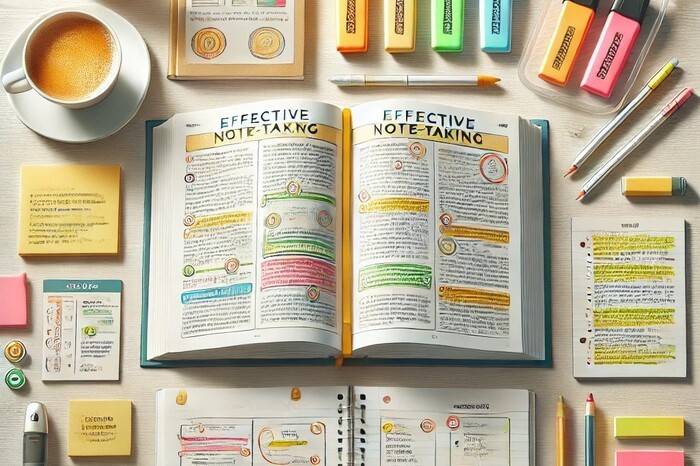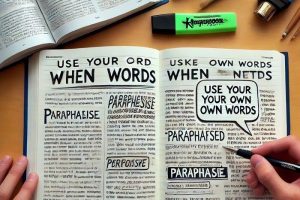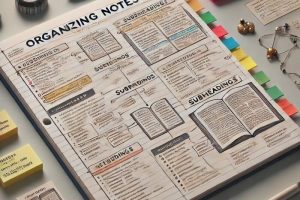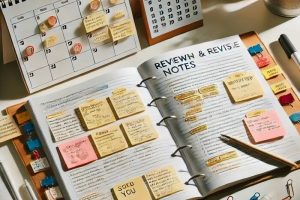
10 Tips for Writing Effective Notes from Your Textbook
Top 10 Effective Note Taking Tips
Effective note taking tips can significantly transform the way you learn. If you have been in college or university, you would relate to the fact that we all keep copying a lot of content from the textbooks but don’t remember anything. Well, this is something we call “’taking notes.” Effective note taking tips can help you retain more information and study better.
It’s a common mistake made by students where they pick up the textbook and blatantly copy contents from the book without learning or memorizing anything. If you want the notes-taking process to be effective, it has to be an active process. This isn’t about constantly scribbling down on your book. Instead, it’s about engaging your brain for learning.
So, if you want to write effective notes that actually help you learn, we are sharing the 10 best tips with you!
1. Active Reading Before Note Taking
Everyone thinks that active reading is all about skimming through the words. However, it’s more about engaging with the content and understanding the meaning. In addition, you’ve to memorize the information. When you skim through the headings, subheadings, and summaries, you will be able to create a proper roadmap in your mind.
This will help you understand the context and structure of the content. As a result, the note-taking process will be more effective and efficient. This is one of the most important note taking tips that improves comprehension. If you don’t know how to ensure proper active reading, we are sharing a few steps:
- You have to read the headings and subheadings. These are the basic points that help you navigate through the content. In simpler words, it will give you an idea about the content in every section.
- After going through the headings and subheadings, you need to read the summaries. These summaries offer a proper overview of the main points.
- Lastly, you need to learn about the concepts and themes in the content. We recommend that you try finding the central ideas and arguments in the content. It will help you understand what the textbook author is trying to say.
Once you’ve a proper understanding of the content theme and structure, you will be able to understand and memorize the finer details. In addition, it will ensure that you don’t get side-tracked while taking notes. Keep in mind that you’ve to stick to the most important points.
2. Use Your Own Words
Many people make the mistake of copying the text verbatim from the textbook but it isn’t effective at all. Instead, you should paraphrase the content. It will help you understand and digest the information. In addition, you will be able to understand the content and express it in words that you can remember. As a result, content comprehension will improve. Now, let’s have a look at some steps that you need to remember.
- You have to understand the main points in the content as well as its relevant details.
- Make sure you don’t change the intent and meaning of the content while paraphrasing it.
- Make sure that your paraphrased content is conveying the same information as the textbook content.
In this step, you’ve to think critically about the content and see how it relates to the current content. This is one of the most effective steps because you’ll be able to memorize the content that you’ve rephrased on your own. That’s because when you present the ideas in your words, you won’t have to worry about plagiarism either.
3. Focus on Key Points
Whenever you take notes, you have to prioritize the important points. For this purpose, you’ve to highlight the main idea in the content, along with important examples and definitions. That’s because focusing on these areas will help you create a proper summary of the content. Among effective note taking tips, prioritizing key points ensures that you retain the most essential information. In addition, it will ensure that you have only the relevant information.
We know you might think that everything is important enough to be highlighted but don’t make this mistake. That’s because over-highlighting the content can lower your productivity. In simpler words, you won’t be able to differentiate between important and non-important points. So, make sure you are selective while highlighting the content in the textbook and only focus on the most important points.
Keep in mind that highlighting only the important details will make sure your notes are easy to understand and review. As a result, you will be able to retain the information and use it properly in your assignments and/or tests.
4. Organize Using Headings and Subheadings
One of the most effective ways to keep your notes organized is to mirror the structure of the textbook. This means using headings and subheadings to categorize information logically. When you follow the same structure as the original material, you’ll create a clear overview of the key points.
Headings and subheadings will be the signposts that guide you through your notes. They help you quickly locate specific information and understand how different concepts relate to each other. When you use headings and subheadings consistently, you’ll make your notes more accessible and easier to review.
Organizing your notes in this way not only improves their readability but also enhances your understanding of the material. It helps you see the big picture and how different pieces of information fit together.
5. Employ Note-Taking Methods
The most effective note-taking method depends on your personal learning style and the complexity of the material. Some popular options include outlining, Cornell notes, mind maps, and charts.
- Outlining: This method involves creating a hierarchical structure with main points and supporting details. It’s useful for linear topics.
- Cornell notes: This format divides your notes into two columns: one for key points and the other for details or questions. It’s a great way to organize information and facilitate review.
- Mind maps: This is a good option for visual learners. This technique involves creating a diagram with central ideas and connecting branches for related concepts. It’s excellent for learning about relationships and connections between ideas.
- Charts: Charts are useful for presenting data or comparing and contrasting information. They can be helpful for visualizing complex concepts.
We recommend that you experiment with different methods and find the one that works best for you. Remember to adapt the format based on the complexity of the content.
6. Add Visuals and Diagrams
Visual aids help improve your understanding and retention of information. Effective note taking tips often include adding visuals and diagrams for easier memorization. We recommend adding drawings, flowcharts, or diagrams to your notes. That’s because it can help simplify complex concepts and make them more memorable.
When relevant, you should use visuals to represent relationships, processes, or data. For example, a flowchart can illustrate a sequence of events, while a diagram can show the structure of a system. In addition, the visuals can break up large blocks of text and provide a visual anchor for key points.
When you use visuals, you’re engaging multiple senses and creating a more engaging learning experience. This can help you better understand the material and recall it more easily.
7. Use Abbreviations and Symbols
Developing a short form for frequently used words can save you time and space in your notes. In addition, using symbols like arrows for relationships or stars for important points can help you visually organize your information. The best thing is that it can help quickly identify key concepts.
When you create abbreviations, make sure they are clear and consistent. For this reason, you should avoid using abbreviations that are too obscure or difficult to remember. Also, symbols should be used in moderation and consistently to avoid confusion.
Also, when you use abbreviations and symbols effectively, you can create more concise and visually appealing notes. This can make your notes easier to review and understand and ultimately help you learn better.
8. Summarize Each Section
There’s no better way of memorizing content than really understanding it. For this purpose, we recommend that you create a summary of every section and chapter. These summaries will help you remember the main points of the content.
When you start summarizing the sections, you’ll be able to synthesize the information. In addition, it will be easier to find the important concepts in the content. It is a great way of finding out where you’re lacking and what you need to improve. Not to forget, these summaries will help revise the content before the exams.
In addition, you need to use clear and simple words while writing the summaries. Similarly, make sure you don’t add extra and unnecessary details because it will make the summary too long.
9. Write Questions in Your Notes
When you’re taking notes and need to revise, remember that you are doing it for retaining the information. For this reason, you have to test yourself and nothing works better than writing questions. These questions will help you test yourself and engage with the content. Also, you’ll be able to recall the information.
When you’re writing questions, make sure they push you to think critically. For example, you should ask the definition and explain it in your own words. Similarly, if you’re trying to memorize the process, make sure you visualize the steps in your mind and explain the steps.
On top of everything, it will help you create a personalized study tool. Also, it will help you identify the weak points in the content. All in all, when you practice the questions, you’ll be able to prepare for the exams.
10. Review and Revise Regularly
Last but not least, you need to review all your notes and revise them on a regular basis. This is one of the best ways of ensuring that your notes have all the latest information and offers a complete view of the content.
We recommend that you review the notes as soon as you write them down. It will help you memorize the content because it’s fresh in your mind. The best thing about reviewing is that you’ll be able to find the points that you need to focus on. In addition, it will help add missing points to the notes, so they are accurate.
On top of everything, regularly reviewing and revising the content will help you understand the connections and patterns in different topics. Following effective note taking tips like regular revision strengthens memory and recall.
Conclusion
By following these effective learning techniques, you’ll find it easier to retain and review information. Taking proper notes is important if you want to perform well in your class. That’s because the majority of classes demand a lot of cramming and reading. The notes-taking process should stimulate your brain to learn and memorize the information. With this article, we have tried mentioning the ten best tips to improve note-taking, so follow them, and you will see the improvement yourself!





